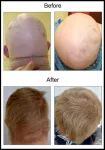(Press-News.org) INDIANAPOLIS — An Indiana University School of Medicine physician scientist is making strides in understanding the molecular origins of fatty liver disease, a leading cause of liver failure in the United States. By identifying the critical role the urea cycle plays in its development, his findings could pave the way for new medications to treat this currently incurable disease.
In a study recently published in Cell Metabolism, Brian DeBosch, MD, PhD, professor of pediatrics at the IU School of Medicine and the study’s corresponding author, uncovered a critical link between defects in the urea cycle, a key process in detoxifying ammonia in the body, and the development of fatty liver disease. Conducted during his time at Washington University in St. Louis, the study found that these urea cycle defects lead to secondary impairment in the tricarboxylic acid (TCA) cycle, a key pathway for energy metabolism. This disruption results in inefficient calorie utilization and excessive fat storage in the liver, which can subsequently cause inflammation and fibrosis, contributing to the progression of the disease.
“Pediatric fatty liver disease can be much more aggressive and more difficult to treat than the adult forms of the disease,” DeBosch said. “Compounding this, there are no approved treatments for pediatric MASLD and MASH, even though MASH is fastest-rising in children. That is why our research is focused on addressing this incredibly urgent need.”
The two types of fatty liver disease are metabolic dysfunction-associated steatotic liver disease (MASLD) and metabolic dysfunction-associated steatohepatitis (MASH). Both conditions involve excess fat buildup in the liver, which can result in liver failure if left untreated. The incidence of MASLD and MASH is rising rapidly among children, where the disease often presents more severely.
DeBosch collaborated on the study with Associate Professor of Surgery and Medicine Yin Cao, ScD, MPH at Washington University in St. Louis. Cao analyzed blood metabolites from a cohort of 106,600 healthy patients from the United Kingdom Biobank. Her examination revealed that certain metabolites associated with nitrogen and energy metabolism, as well as mitochondrial function, can predict the risk of severe liver diseases even in healthy individuals. Cao said the findings from this translational study, also backed by mouse research, underscore the critical role of the urea cycle in understanding severe liver diseases.
“MASLD and MASH are significant health concerns that are closely associated with other metabolic conditions and an increased risk of various cancers,” she said. “This discovery holds promise for breakthroughs in the prevention and treatment of these serious conditions.”
In a 2022 Cell Reports Medicine study, DeBosch and his team found that administering an enzyme called pegylated arginine deiminase (ADI-PEG 20) significantly improved symptoms of fatty liver and obesity in mice, offering promising insights for future therapies. Their latest findings further suggest that targeting nitrogen handling in the liver, a process linked to the urea cycle, could be an effective treatment approach.
Additionally, their research demonstrated that giving mice a precursor to adenine dinucleotide (NAD+), an important intermediary that fosters TCA cycle function, also improved function in their study models. Looking ahead, DeBosch plans to continue exploring the effects of ADI-PEG 20 and NAD+ to investigate their molecular connections between the urea and TCA cycles.
"I want to explore the best pathways to target these defects so future drugs leveraging this biology can be more effective and precise in treating individuals with fatty liver disease," DeBosch said.
DeBosch joined the IU School of Medicine Department of Pediatrics in July 2024 to lead the newly established nutrition and molecular metabolism research program at the Herman B Wells Center for Pediatric Research. He is also the new co-division chief of gastroenterology, hepatology and nutrition at Riley Children’s Health.
“We’re thrilled to have Dr. DeBosch join our team at the Wells Center and look forward to the innovative contributions he will bring to our new nutrition and molecular metabolism research program,” said Reuben Kapur, PhD, director of the Wells Center. “His expertise is invaluable as we work to enhance the health and well-being of children across Indiana.”
A nationally recognized expert in gastroenterology and nutrition, DeBosch aims to advance the understanding of the gut determinants of metabolic disease and develop innovative treatments that improve outcomes for pediatric patients. His laboratory focuses on researching diseases including fatty liver disease, cardiovascular disease and Type 2 diabetes.
“I'm excited to join the IU School of Medicine and the Wells Center,” said DeBosch. "This opportunity allows me to collaborate with incredible physicians and scientists while continuing to prepare the next generation of experts in the field. I look forward to contributing to the center's mission of improving pediatric health outcomes in Indiana and well beyond.”
About the IU School of Medicine
The IU School of Medicine is the largest medical school in the U.S. and is annually ranked among the top medical schools in the nation by U.S. News & World Report. The school offers high-quality medical education, access to leading medical research and rich campus life in nine Indiana cities, including rural and urban locations consistently recognized for livability. According to the Blue Ridge Institute for Medical Research, the IU School of Medicine ranks No. 13 in 2023 National Institutes of Health funding among all public medical schools in the country.
Writer: Jackie Maupin, jacmaup@iu.edu
Sources: Brian DeBosch, bdebosch@iu.edu, and Yin Cao, yin.cao@wustl.edu
END
New research explores the urea cycle’s strong connection to fatty liver disease
2024-08-13
ELSE PRESS RELEASES FROM THIS DATE:
Two new studies show how immunotherapies collaborate to boost T cell responses in melanoma
2024-08-13
Two studies published in the latest issue of the journal Cell by University of Pittsburgh researchers uncover how immunotherapies targeting the immune checkpoints PD1 and LAG3 work together to activate immune responses. The findings shed light on why combination therapies targeting both checkpoints can improve outcomes for melanoma patients compared to monotherapies targeting only PD1.
Using data from a human clinical trial and animal models, the researchers investigated responses of tumor-killing CD8+ T cells. During extended battles with cancer, immune checkpoints accumulate on the surface of T cells, acting like brakes on ...
Less sleep and later bedtime in childhood linked to future substance use
2024-08-13
UNIVERSITY PARK, Pa. — A good night’s sleep is essential for children’s health and development, but childhood sleep patterns may also be linked to future substance use. A new study, led by a team of Penn State researchers, found that adolescents were more likely to have consumed alcohol or tried marijuana by age 15 if they went to bed later and slept fewer hours during childhood and adolescence. The team published their findings in Annals of Epidemiology.
“The study suggests that there might be some critical ages when sleep can be a target for intervention,” said Anne-Marie Chang, associate professor of ...
C-Path’s TRxA announces $250,000 grant for drug development project on antibiotic-resistant gram-negative bacteria
2024-08-13
TUCSON, Ariz. August 13, 2024– Critical Path Institute’s (C-Path) Translational Therapeutics Accelerator (TRxA) announced today that Kenneth Keiler, Ph.D., Professor of Molecular Biosciences at the University of Texas at Austin, has been awarded a research grant for his innovative project titled “Inhibitors of the Gram-negative Cell Envelope Stress Response as Anti-Infectives and Antibiotics.” This funding will support Dr. Keiler’s original approach to addressing the critical issue ...
Crnic Institute clinical trial shows JAK inhibitor improves multiple autoimmune conditions in patients with Down syndrome
2024-08-13
A new study published in eLIFE by researchers from the Linda Crnic Institute for Down Syndrome (Crnic Institute) at the University of Colorado Anschutz Medical Campus reports the initial results of a first-in-kind clinical trial testing the safety and efficacy of a JAK inhibitor to decrease the burden of autoimmune conditions in people with Down syndrome. The clinical trial, which is funded by the National Institute of Arthritis and Musculoskeletal and Skin Diseases, is part of a portfolio of new clinical trials supported by the National Institutes of Health INCLUDE Project.
Drawing upon their 2016 discovery that the interferon ...
New study looks at drug exposures of COVID-19 therapy for pregnant people
2024-08-13
A new study provides important insights into the pharmacokinetics and safety of intravenous remdesivir in treating the SARS-CoV-2 coronavirus in pregnant women.
Remdesivir is an antiviral medication and is used to treat certain patients with COVID-19 who are either hospitalized or have mild-to-moderate symptoms in the outpatient setting and are at high risk of severe disease.
The study, published in the Journal of Infectious Diseases, is the first pharmacokinetic study to be published on a COVID-19 therapy in pregnant women. Pharmacokinetic studies ...
Business crucial to addressing toxic pollution and protecting human health
2024-08-13
By Josh Stowe
Toxic pollution is the single largest cause of death and poor health, killing up to 9 million people each year — about 100 times more than war and terrorism combined. Business produces the bulk of this deadly pollution, but can also play a critical role in addressing it and mitigating its effects, according to new research by University of Notre Dame expert Richard (Drew) Marcantonio.
Marcantonio, whose study was recently published in Business Horizons, is assistant professor of environment, peace and global affairs in Notre Dame’s Keough ...
SwRI-led team finds evidence of hydration on Psyche
2024-08-13
SAN ANTONIO — August 13, 2024 —Using data from NASA’s James Webb Space Telescope, a Southwest Research Institute-led team has confirmed hydroxyl molecules on the surface of the metallic asteroid Psyche. The presence of hydrated minerals suggests a complex history for Psyche, important context for the NASA spacecraft en route to this interesting asteroid orbiting the Sun between Mars and Jupiter.
At about 140 miles in diameter, Psyche is one of the most massive objects in the main asteroid belt. Previous observations indicate that Psyche is a dense, largely metallic object that could be a leftover core from a planet that experienced ...
$18M ARPA-H award supports Rice-led research on tumor analysis system for breast, head and neck cancer
2024-08-13
A Rice University-led multi-institutional research collaboration has won an award of up to $18 million over five years from the Advanced Research Projects Agency for Health (ARPA-H) to develop and validate a new system for improving tumor removal accuracy for two types of cancer: breast, and head and neck cancer.
Called AccessPath, the novel, affordable, slide-free cancer pathology system will help surgeons know whether they have completely removed tumors during surgery by enabling rapid, automatic tumor margin classification of resected tumors. AccessPath is one of several projects funded through the ARPA-H Precision Surgical Interventions program announced today ...
Common equine painkiller disrupts assisted reproduction technique efficiency in mares, Texas A&M research finds
2024-08-13
By Courtney Price, Texas A&M University School of Veterinary Medicine and Biomedical Sciences
Researchers at the Texas A&M School of Veterinary Medicine & Biomedical Sciences (VMBS) have discovered that phenylbutazone, a non-steroidal anti-inflammatory drug (NSAID) commonly prescribed in horses, can affect the ability of a mare’s egg cells — called “oocytes” — to become viable embryos, which is a crucial step in assisted reproduction in horses.
This discovery, recently published in the journal Theriogenology, is significant because of the time and money that horse owners ...
Coherence entropy unlocks new insights into light-field behavior
2024-08-13
Light technology is at the heart of many cutting-edge innovations, from high-speed internet to advanced medical imaging. However, transmitting light through challenging environments, such as turbulent atmospheres or deformed optical systems, has always posed a significant hurdle. These complexities can distort and disrupt the light field, making it difficult to achieve clear and reliable results. Scientists have long sought ways to overcome these limitations, and a new breakthrough may hold the key to advance practical applications.
As reported in Advanced Photonics, researchers at Soochow ...





